These Are the 6 Best Ski Helmets You Can Pick Up for the Season

If you purchase an independently reviewed product or service through a link on our website, Rolling Stone may receive an affiliate commission.
Even as concerns about the effects of global warming continue to plague the ski resorts across the country, snowbirds and daredevils alike have certainly enjoyed the first major dump of snow of the year across the Northeast and Pacific Northwest.
More from Rolling Stone
The 'Mean Girls' Reboot Is Here - Where to Buy Movie Tickets and Stream the Original Online
These Acoustic Wall Panels Make Any Room a Quiet Place to Work or Relax
With hefty snow accumulation comes more places to ski and ride well into the next few months across Vermont, California, Utah, Colorado and more. Overall, this season is tentatively shaping up to be an exciting one for skiing and riding: but even if you’re experiencing warmer winter days and stripping down layers of bulk (I’ve seen everything from hoodies and jeans to dinosaurs onesies on the slopes this year), the one thing you should never ride without is a solid helmet.
The best ski helmet should be your number one priority — yes, even before the goggles, boots, or jackets. When putting together your complete ski kit, consider that you don’t have to compromise safety for style. There are slick-looking, higher-end models that offer features like a more customizable fit and venting, but even more budget-friendly options for those of us who only hit the mountains a few times a year that’ll still be durable (and you can always decorate with resort stickers!). Even if you’re new to skiing, it’s still a good idea to invest in a solid helmet, since you might be taking a few more tumbles than your more experienced colleagues on the mountain.
However, if you’ve never shopped for ski helmets before, it can seem like a daunting task with all the terms, fits, and brands to figure out. To help you get properly suited up, we’ve put our heads together (pun intended) to find the best ski helmets currently available online. Our picks are based on personal testing on the slopes, as well as top-rated picks from well-trusted brands. Read on for our top choices, as well as a brief shopping guide to finding the best ski helmet for you.
In This Article
What Are the Best Ski Helmets?
Ski Helmet Types and Construction
Buying Guide: How We Chose the Best Ski Helmets
What Are the Best Ski Helmets?
No matter what type of skiing you’ll be doing — or your skill level — the answer is yes, you do need a helmet. Here are the best ski helmets we’ve found, taking into consideration factors such as comfort, durability, goggle compatibility, and more.
BEST OVERALL: Smith Nexus MIPS
BEST DESIGN: Oakley MOD7
BEST FOR BACKCOUNTRY SKIING: Salomon MTN Lab
MOST COMFORTABLE: Wildhorn Drift
MOST DURABLE: Sweet Protection Igniter 2Vi
1. Smith Nexus MIPS

Widely considered to be the Lamborghini of ski helmets, you’ll never find a more impressive fit or advanced protection than with the Smith Nexus MIPS. It’s seriously hard to top, since it not only looks sharp, but feels great too — we had no problems using the simple dial on the back to find the perfect fit, and the quick-snap magnetic buckle made the chin strap easy to take off, even with our gloves on.
Speaking of comfort, this helmet felt like it weighed almost nothing while skiing. According to Smith, beefing up the durability while keeping the helmet so lightweight is thanks to its hybrid shell construction. This combines an impact-resistant exoskeleton, Koroyd material (which absorbs any direct and side impact without weighing you down), and MIPS tech, which more efficiently slides within the helmet when you get hit to reduce the rotational force (better than EPS foam-constructed helmets).
If you run hot even on the slopes, we loved how breathable this helmet was, with a whopping 24 vents that can be opened and closed to tailor to your warmth level (a sweat-wicking liner minimalists odor too). Bottom line? The Smith Nexus MIPS is the creme de la creme of outdoor gear, and should be your first choice before you the slopes.
$325
2. Oakley MOD7
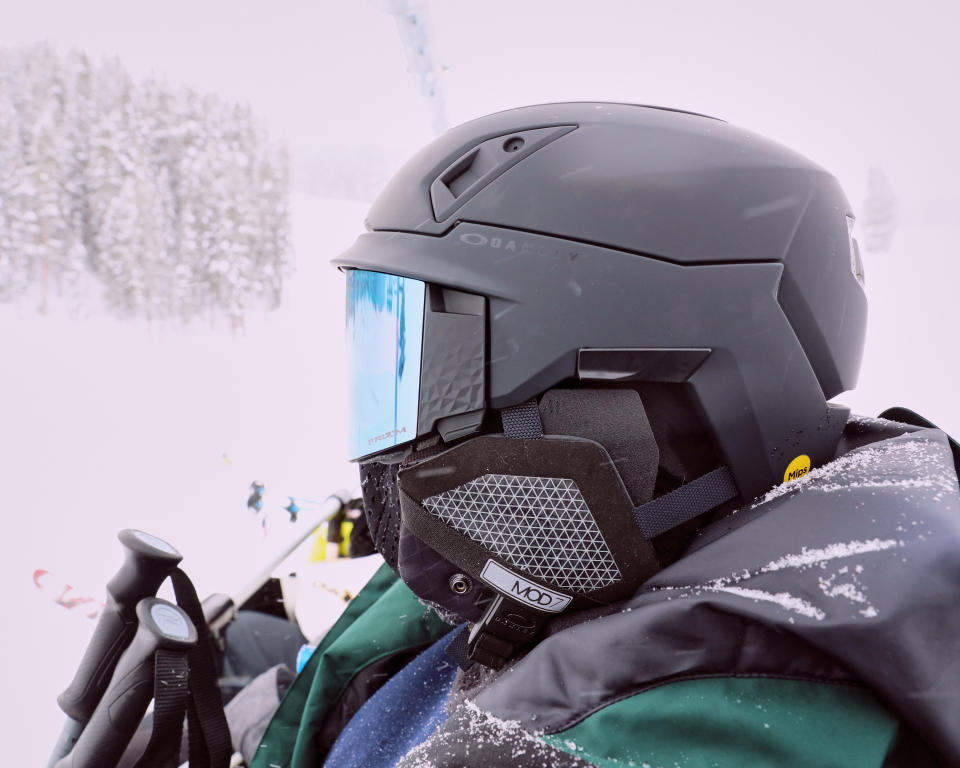
Innovative, stylish, and downright cool, the Oakley MOD7 is the best-looking helmet you could wear on the mountain, period.
MOD7’s highlight is Oakley’s groundbreaking “Secure-Connect” visor tech, which lets you magnetically connect and secure the visor in place, but unlike other helmets with built-in visors, can also easily detach from the front “riding” position and snap to the top of the helmet like a traditional goggle. This way, it’s a simpler and more functional visor design, and you get benefit of the brand’s special lenses, which had some of the best contrast and enhanced clarity on our list, and was great for detecting bumps, textures and other obstacles on the snow.
While the snapping visor took some trial and error to get right, once you get a feel for the motion, it’s a snap with gloves on. We really loved that you were able to adjust the seal of the lens with a button on the side of the helmet for a custom fit (mountaintop winds were no match!). With the eye-catching visor-helmet design and adjustable fit, the MOD7 is busting the myth that protective gear needs to look purely functional to keep you riding safely.
$416.22 $490.00 15% off
3. Salomon MTN Lab
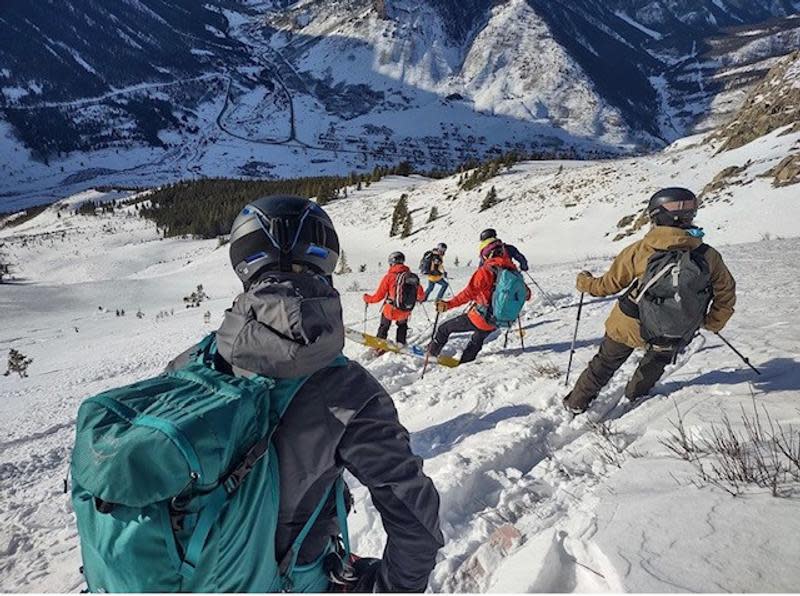
Thinking of trying some backcountry skiing? You’re going to want to pick up this Salomon MTN Lab helmet. As a backcountry helmet, the MTN Lab can transition between regular downhill runs to steep mountain missions with ease. This ability rests on its feathery light 12.9-ounce weight, which wins serious points for its ability to be worn all day, or attached to a pack for climbing.
While skiing in the backcountry, the helmet’s ventilation is a standout feature — with 12 large vents along the top and sides of the lid, it kept us cool during particularly warm bluebird days. When you’re ready for a resort run, the helmet is prepared for warmth with two cozy 100% natural Merino liners, which are also sweat-wicking. That being said the helmet keeps the padding to a minimal, so if you run cold, it won’t be as insulating as other lids. That, combined with its in-mold construction, helps cut a lot of bulk to stay lightweight, but won’t be as durable as, say, ABS or hybrid helmets.
But from a performance standpoint, the MTN Lab is triple-norm certified for skiing, climbing, and biking, and with a super light build, this backcountry companion won’t weigh you down.
$199.95
4. Wildhorn Drift
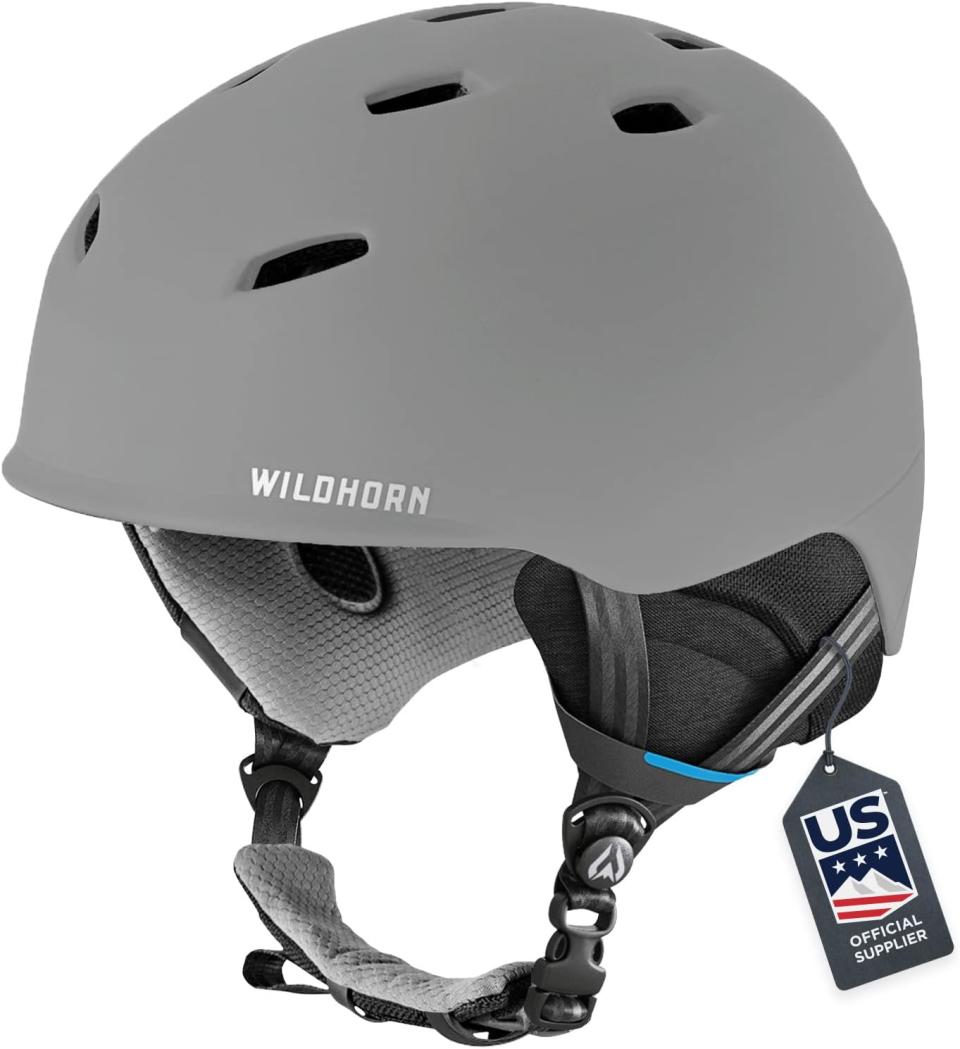
As the official supplier of the U.S. Ski Team, you can trust that Wildhorn knows their stuff when it came to designing the best-selling Drift helmet. It’s one of the most ergonomic, comfortable helmets we’ve ever tested, with plush ear pads and adjustable ventilation for any weather condition we faced on the slopes.
With 13 vents (three near the front, eight on top, and two in the back), it’s great for spring skiing when you can open all eight vents on the top, and we definitely noted the increased warmth when we closed them riding on cold days (10 degrees F) and in windy conditions. It also feels incredibly lightweight but remained secure, with an easy-to-use dial in the back of the helmet that allows you to fine-tune the sizing cage inside the helmet.
As comfortable as it feels, that doesn’t mean it skimps on safety — the Highline incorporates MIPS tech (to reduce rotational impact), and the goggle strap can be snapped on, so your eyes will stay protected if you yard sale out on the slopes. Your gear should always feel like an extension of your body, and Wildhorn’s Drift totally excels in this vein.
$93.49 $109.99 15% off
5. Sweet Protection Igniter 2Vi
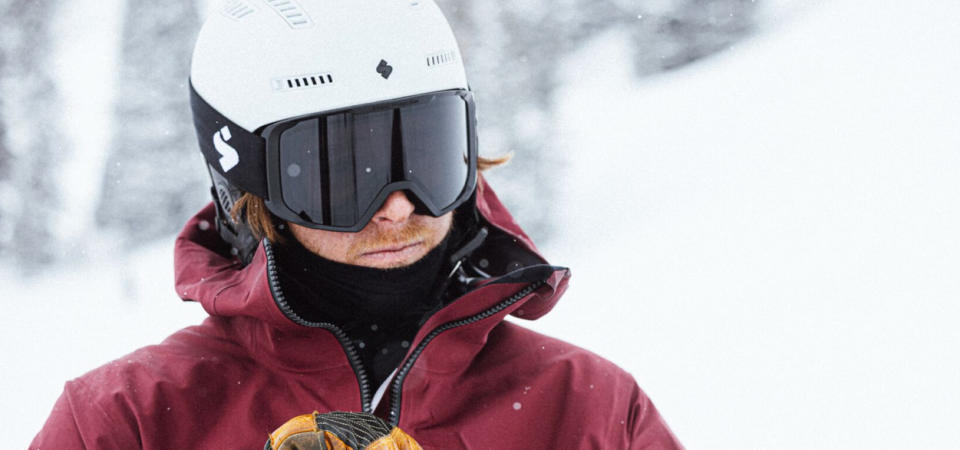
If you’re on your second concussion of the season (true story), or you just want to make sure your head is an impenetrable fortress when you’re speeding downhill at 20 mph, the Igniter 2Vi’s got your back (and your brain) covered.
There’s no such thing as over-designed here — your multiple lines of defense include a hardshell molded to the shape of the human skull for a contoured fit, a multi-density, shock-absorbing foam liner to protect from direct hits, and dual-layer MIPS protection from rotational impacts.
The 2Vi also has an “Occigrip” construction that does exactly what it does like, and gave us a firm yet comfortable fit when we tried it that wouldn’t budge or roll around on our heads. It’s also adjustable on the fly in both reach and height with a dial fit system that locks in quickly. There’s not only 10 large “penetration-proof” vent ports, but the goggle garage also has goggle vents (we rarely experienced fogging because of this).
Overall, the Sweet Protection Igniter 2Vi is an excellent performance helmet that offers maximum protection for thrill-seekers and bunny hill-frequenters alike.
$229.95
6. Giro Ledge MIPS
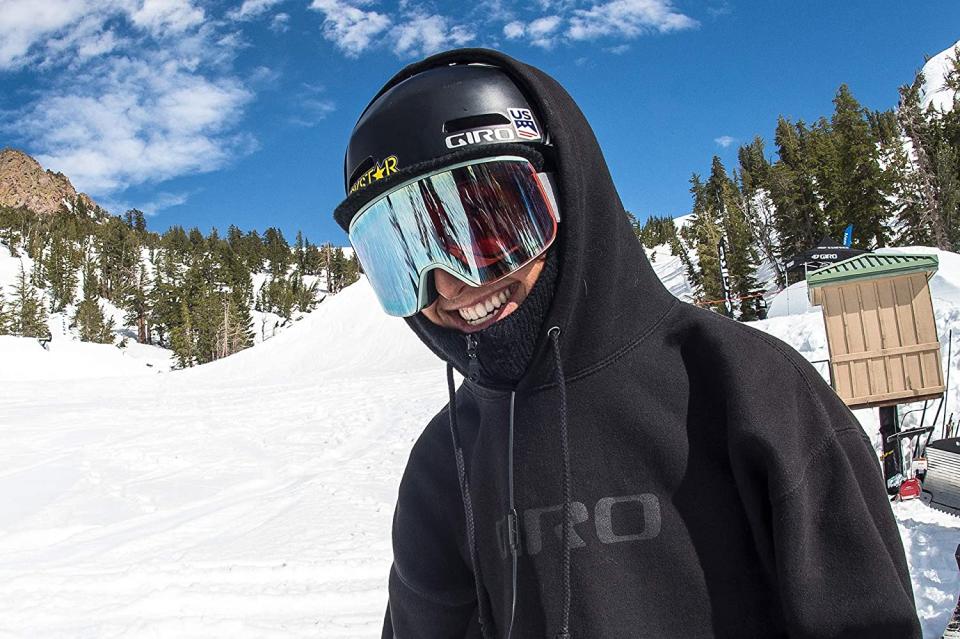
If you’re looking to save a few bucks (we all know how ski gear can add up), the Giro Ledge is hard to beat, delivering the best ratio of protective benefits to price point of any ski helmet out there right now.
You’ll get all your bases covered, safety first with its tough ABS hardshell, and then combined with top-tier MIPS tech that’ll absorb the force of angled impacts like we’ve mentioned before. You usually only find this safety system in higher-end competitors, so we love that you can find it for around $120. The rugged outer shell is attached to an EPS foam liner, which isn’t terribly plush, but it’ll get the job done.
There’s not a ton of bells and whistles here, but we find a few key features to highlight during our testing — mainly Giro’s “Sack Vent” in the front of the helmet that aligns with your goggles and helped to keep us clear and fog free for several runs at a time. The vents on the top of the helmet also kept us cool, but if you run cold, there are definitely helmets with better insulation. But their vertical tuning system made it simple to adjust the fit and goggle set-up without removing our helmets, so if you wear a beanie and dial it in, you should be good to go. The goggle retainer hook in the back also kept everything secure, and the ear pads were easy to remove.
You don’t have to sacrifice your budget for performance, and the Giro Ledge MIPS proves our point exactly.
$119.95
Ski Helmet Types and Construction
Ski helmets can be broken down into three types when we’re taking about construction: ABS, in-mold, and hybrid in-mold. There’s pros and cons for each type depending on what you’re looking for out of your ski helmet.
ABS is best when it comes to durability, since it’s a hard plastic shell with a foam liner glued to the inside. The construction is simple, but tough as nails, and can take damage like dings and dents after a few years of wear without showing. They also win points for affordability, which makes them great for beginners or those who don’t ski all season. But that’s at the expense of weight and ventilation, since their durability also makes them bulkier than other helmet types.
In-mold instead features a thin shell (typically polycarbonate) molded together with an EPS foam liner. Because this results in one combined piece, in-mold helmets absorb impact as a single unit but cuts out a lot of the weight of ABS models. These lightweight helmets also have improved ventilation, although you’ll sacrifice some durability, include cosmetic damage like scratches.
For the best compromise between the two, hybrid in-mold helmets have an additional hardshell layer to improve durability. This also tends to make then a bit heavier than in-mold helmets, but they’re a better option for freestyle or park riders, or backcountry skiers taking on serious mountain terrain. Aesthetically, they’ll also last longer (and stay unblemished) thanks to their build, but this increases the price point to $250+. That’s why they’re popular for athletes and serious skiers, but maybe not for beginners.
Buying Guide: How We Chose the Best Ski Helmets
Although not as technical as skis or ski boots, there are still a few things to know about ski helmets before pulling the trigger on a new one. Here’s what we looked for while testing the best ski helmets online.
Safety and Construction: Instead of simply stopping superficial injury, the best ski helmets actually absorb impact. All of the helmets on this list offer quality protection through impact-absorbing foam, durable shells, or MIPS tech (multidirectional impact system) to reduce rotational impacts that cause brain injury.
Ventilation: Because the conditions on the mountain can change on dime from freezing winds to sweltering sun, you’ll want a helmet with various temperature control options. We prioritized helmets with adjustable vents over insulation since you can get cooling airflow on warm days and protection on cold ones.
Fit Adjustability: Helmet fit is key to your protection, especially if you’re wearing bulky beanies or headbands underneath. Most of the helmets on this list come with built-in, adjustable harnesses you can adjust on the fly, or external dial system you can turn even with gloves on.
Weight: Ski helmets vary by weight, but that extra bulk will be noticeable after a long day on the slopes, especially if you’re backcountry skiing with a loaded pack. This list features a combination of lightweight picks and tank-like helmets, but nothing exceeds 13 ounces.
Best of Rolling Stone

